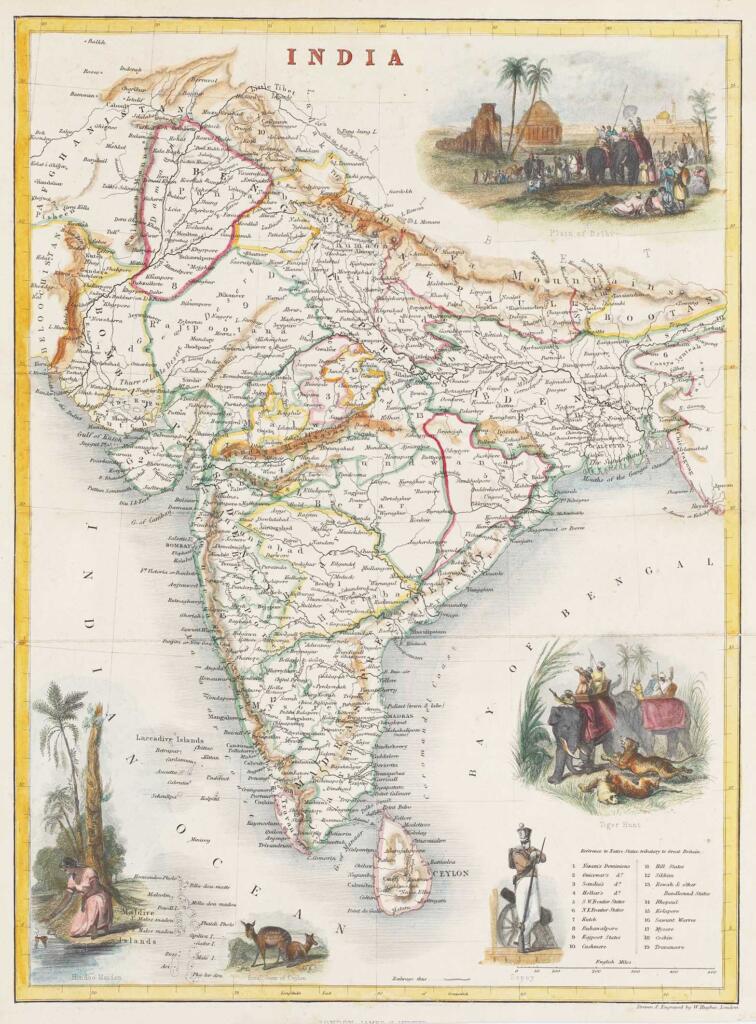
India, c.1850s, map by William Hughes, published by James S Vertue
Over a long phone conversation during a short break in Nainital, author and historian Dr Anirudh Deshpande evocatively sketched for us the political landscape of the Indian subcontinent after the fall of the last great Mughal. The period after the death of Aurangzeb in 1707 and preceding the establishment of the new British Raj in 1858 is often referred to as the post-medieval period in Indian military history. We at Sarmaya were curious about the specifics of this period, from the key leaders and battles, to the definitive political power struggles and military innovations. Dr Deshpande told us about all that and more in this conversation.
Tell us a little bit about the political climate in the post-medieval period and who were the key players that emerged as Mughal power declined in India?
“Practically the whole of India was dotted with polities, which were either the successors of the Mughal Empire or those that had emerged as a consequence of various zamindari rebellions against the later Mughals. This process created what in historic parlance is called the 18th-century Indian principalities with their roots stretching back to the 17th century. These polities flourished in the 1700s, sometimes in conflict with each other and often in conflict with the East India Company, which defeated them one by one starting in 1757 [with the Battle of Plassey]. The key Indian political players at the time were the Marathas, Sikhs, the Mysore kingdom, the Rajputana, the Nizam of Hyderabad, Bengal, Awadh, the Rohillas and the Jats, close to Delhi and Agra.”

‘Storming of Seringapatanam’, 1802-03, by Giovanni Vendramini after Robert Ker Porter—click on image to read more
What battles from this period—and there were many—would you say were the most prominent?
“One of the most important developments in the 18th century was the elimination of the French influence from India—the French were ultimately confined to Pondicherry at the mercy of the British East India Company. This was the consequence of the Battle of Wandiwash (1760) in which the French were decisively defeated by the British. One could sometimes speak of the Third Battle of Panipat (1761) between the Marathas and the Indo-Afghan alliance, but the significance of this battle is exaggerated in nationalist historiography. The Marathas recovered many of their territories after the defeat of 1761. The Battle of Plassey (1757) and Battle of Buxar (1764) were smaller in scale, but established British power firmly in Bengal, the richest province of India. From Bengal, the Company accessed the large military labour market of north India and raised the Bengal Army, which became the most important instrument of British imperial conquest in India during the 19th century. The Mysore Wars between the Company and the father-son duo of Hyder Ali and Tipu Sultan during the latter half of the 18th century were hard fought and historically significant. The siege of Srirangapatnam and the death of Tipu Sultan in 1798-99 during the Fourth (and last) Mysore War proved to be turning points in the history of south India. Not only did Tipu’s defeat allow British access to Malabar, but it also gave them a base for their campaign against the Marathas from 1802 onwards. After the Mysore Wars, the Second Anglo-Maratha War (1803-05) practically finished off what was called the Maratha Confederacy. Finally, the conquest of Sindh and the swift demise of Sikh power following the death of Maharaja Ranjit Singh in 1839 could also be considered important events in the military history of modern India.”
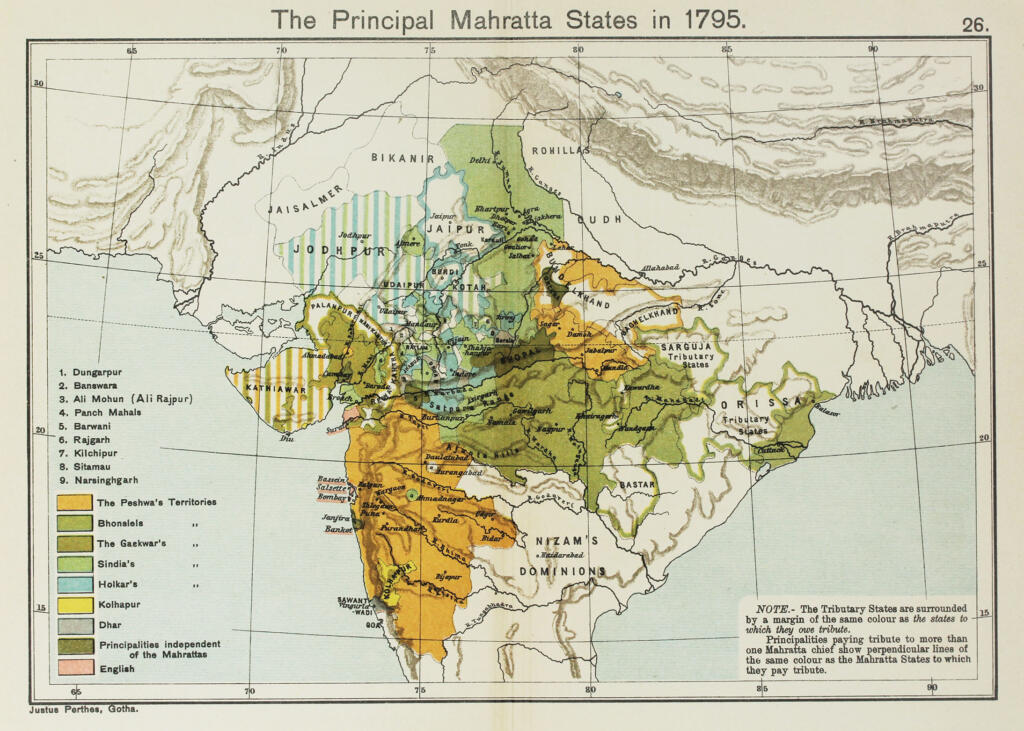
‘The Principal Maratha states in 1795’, 1914, map published by Justus Perthes, Gotha
But the British had a tough time battling the Marathas at Assaye in 1803, didn’t they?
“At Assaye, the Marathas fought very well. The Shinde battalions were drawn largely from the military market of north India. Further, because of Maratha military modernisation in the 18th century, initiated by Malharrao Holkar and Mahadji Shinde post 1761, there was little to distinguish between the Company and the Maratha battalions. Like the Sikhs, the Maratha Sardars had developed powerful artillery parks, which created killing fields through which the Company troops had to advance before engaging with the Maratha infantry. The Battle of Assaye was almost lost by the British, but Arthur Wellesley finally carried the day because of his disregard for battlefield casualties. In his old age, Wellesley remembered Assaye as the toughest battle of his life and not Waterloo! But let me add that General Lake, a disciplined soldier, played an important role in destroying Maratha power in the north by winning for the Company the Battle of Laswari. This brought Aligarh, Delhi and Agra under direct Company influence after 1803. People usually remember Wellesley, the future Duke of Wellington, but overlook the achievements of General Lake.”
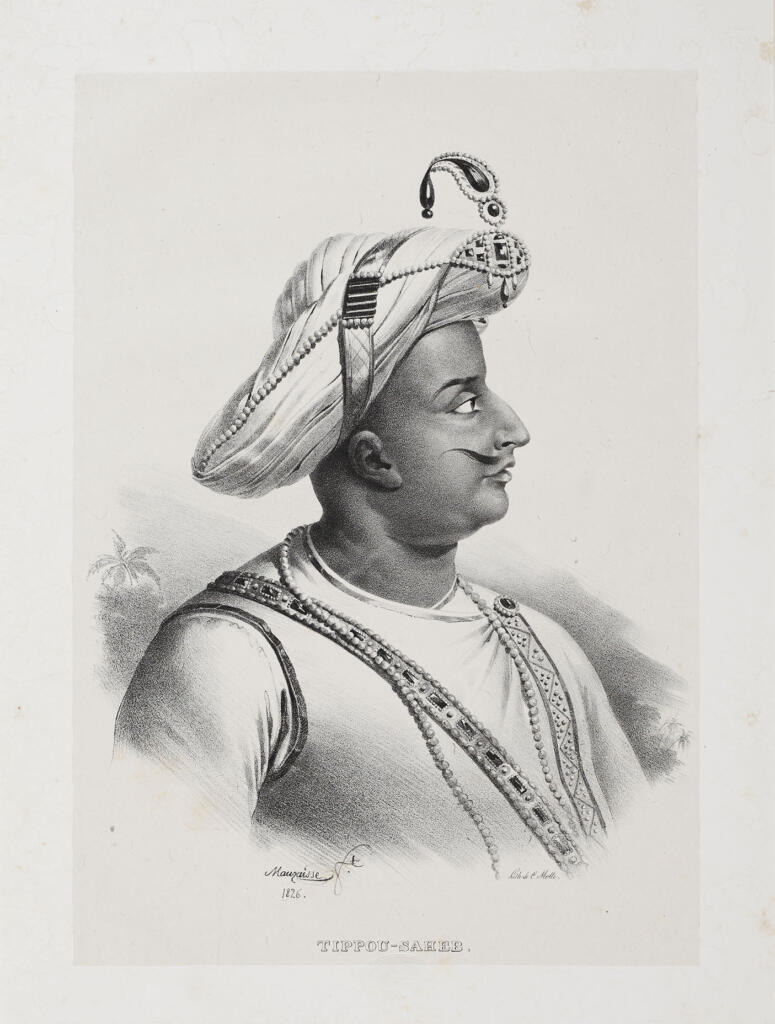
Portrait of Tipu Sultan, 1826, by Charles Motte, after a drawing by Jean-Baptiste Mauzaisse
Who are your favourite war heroes from this era?
“General Mohan Lal of Siraj ud Daulah’s army fought valiantly at Plassey. There were many such Indian commanders. In fighting the Company, both Hyder Ali and Tipu Sultan were outstanding—the Company was truly scared of them. Another military genius from the period stretching from the late 17th to early 18th centuries was Guru Gobind Singh, founder of the Khalsa, which later became the foundation of Sikh power in the Punjab. We must also remember Baji Rao I while speaking of Indian generals of the 18th century. I have no favourites, however, the Indian subcontinent produced several intrepid military leaders in the 18th century, including Ahmad Shah Abdali, Ibrahim Khan Gardi and Ranjit Singh (in the early 19th century). It is not the job of historian to seek war heroes because war, in general, is not heroic. Military historians, if such creatures exist, only try to understand the character and role of military individuals in their context.”
Indian military history indicates the presence of communal amity, whether it is Sultan Mahmud Ghazni’s large Hindu slave contingent or the presence of Muslim soldiers and commanders in the Maratha army. There are also cases of Hindus and Muslims having formed military coalitions against common enemies. Could you tell us a bit about this?
“One of Sultan Mahmud Ghazni’s favorite commanders was the enterprising Kashmiri Tilak who played an important role in putting down some Muslim rebellions in Afghanistan. At the Battle of Khanwa (1527), the Mewaris and Mewatis under Hasan Khan Mewati fought together against Babur. Hasan Khan was killed in action. The armies of Sher Shah Suri that defeated Humayun comprised Muslims and Hindus. The army of the Indo-Afghans, which battled young Akbar at Panipat (1556), was led by Himu, a Hindu general. Later at the Battle of Haldighati (1576) the vanguard of Rana Pratap’s army was led by a Muslim commander, Hakim Sur Afghan. The Maratha and Mysore armies were also religiously heterogeneous and the commander who fought the hardest for the Peshwa at Panipat (1761) was the French-trained Ibrahim Khan Gardi, also a Durrani like Ahmad Shah. There was great friendship between some Maratha Sardars and Muslim leaders—for instance Malhar Raoji Holkar a veteran Maratha commander in north India in the 18th century was a close friend of Najib-ud-Daulah. I would say the 18th-century rulers employed people for their abilities and their actions cannot be painted in communal colors. Guru Gobind Singh, for instance, fought against the Mughals all his life. But when the old Bahadur Shah ascended the throne after the death of Aurangzeb, the Guru accompanied him to the Deccan. The Sikh armies raised by Ranjit Singh were also secular in composition— he employed Muslim ministers and military commanders. “
Let’s talk a little bit about military innovations. The Mughals, for instance, were the first to use cannons in India. Were there more such from this period?
“Actually, the first ones to use cannons systematically in India were the Portuguese. Gunpowder and fireworks had appeared in India as early as the 14th century but Babur introduced cannon-based warfare and technology in north India in 1526. Babur was influenced by Ottoman gunpowder technology and had drawn lessons from the Battle of Chaldiran (1514) where the Ottomans had defeated the Safavid Persians by a skillful use of artillery. The development of gunpowder technology in Mughal India was a major innovation and Babur’s victories at Panipat (1526) and Khanua (1527) can be ascribed to his mastery of cannonade and matchlock fire.”
“In the 17th and 18th centuries, India was a big firearm manufacturer. Guns were manufactured in many cities, towns and even villages where expert gunsmiths resided. Some of the guns manufactured in India at the time were considered superior to the arms used by even the Europeans. The Afghan long barrel musket called jezail was particularly accurate and feared. The armies led by Abdali deployed a variety of heavy and light artillery and mobile guns were mounted on camels and elephants. Swivel guns were also used in large numbers. The rockets used by the troops of Tipu Sultan, called ban, were of various types and were fairly evolved. It is said that the rocket technology developed in Europe during the 19th century, one of the chief innovators of which was (Sir William) Congreve, is said to have been inspired by samples of Indian rockets taken to Europe and England. Records show that Indians had mastered gunpowder technology and manufactured handguns called tamanchas and long-barrel muskets called tufangs or bandooks.”
“Historians attest to the rich history of metallurgy and cannon manufacturing in India in the 18th century. Later, in the 19th century, English officers observed that the curved Indian talwaar often proved more effective in hand-to-hand combat compared with the straight sword. Therefore, keeping these developments in mind, medieval India cannot be seen as a dark age. Let us not forget that even great military innovators like Shivaji enlisted Portuguese experts to develop their artillery and fortifications. In medieval and early modern India, military technology and innovation were driven by a combination of Indian manufacturing skill and Ottoman and Portuguese technology. Later, in the 18th and 19th centuries, the Dutch, French and English also played an important role in this process.”
In 1822, Maharaja Ranjit Singh hired European mercenaries to train his troops. Was this unusual or part of the norm of the time?
“The history of the Sikh Empire belongs to the first four decades of the 19th century. From around 1800 Ranjit Singh emerged as a major player in north Indian politics. A strange kind of kingdom developed under him because the Sikh faith doesn’t sanction monarchy. The religion had evolved as a communitarian, democratic, egalitarian movement amongst the peasantry in North West India. Ranjit Singh was an astute observer of political affairs in India and realised that he would have to modernise the Khalsa Army. Although the Sikhs were brave, they had to be trained in new warfare, which underpinned the success of the Company in India. Hence, European mercenaries were hired by Ranjit Singh and the Dal Khalsa eventually became a formidable fighting force. Even the East India Company battalions were afraid of the Khalsa army, which had defeated the Afghans and the Frontier tribes on numerous occasions. The Sikhs possessed excellent artillery and smaller firearms, many pieces of which are displayed in the Patiala museum. Even the Mysore armies were well-trained, modern and fought according to contemporary standards of infantry fighting and other maneuvers. Hyder and Tipu developed expert assault and rocket battalions dressed in uniforms. These can be seen as the forerunners of latter day commandos.”
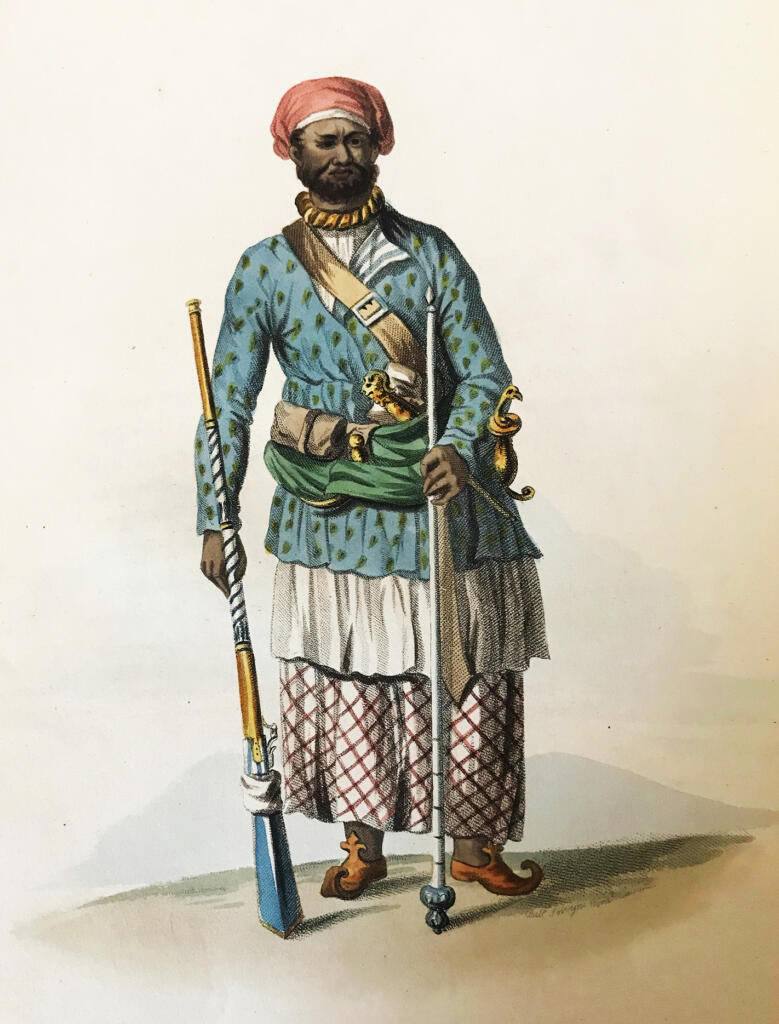
A Seapoy, lithograph from The Costume of Hindostan by Baltasar Solvyns, 1807
Speaking of uniforms, what did these various armies look like at the time?
“By the late 18th century, all the Indian armies began to wear uniforms under European influence. In the 17th century or the early 18th, most armies fielded by Indian powers didn’t wear uniforms. The Maratha army did not wear uniforms except for the Bussy-trained artillery and infantry of Ibrahim Khan Gardi. Shuja ud Daulah’s troops were dressed in quilted angrakhas and wore light armour. The Muslim troops wore achkans. The Maratha troops were usually dressed in dhotis and short kurtas or bandis. The spear, sword and shield were their chief weapons. The generals and commanders wore armour. Of course, Indian troops carried flags, battle standards, drums etc. but the regimental military band became a formal unit of the army under the Company.”
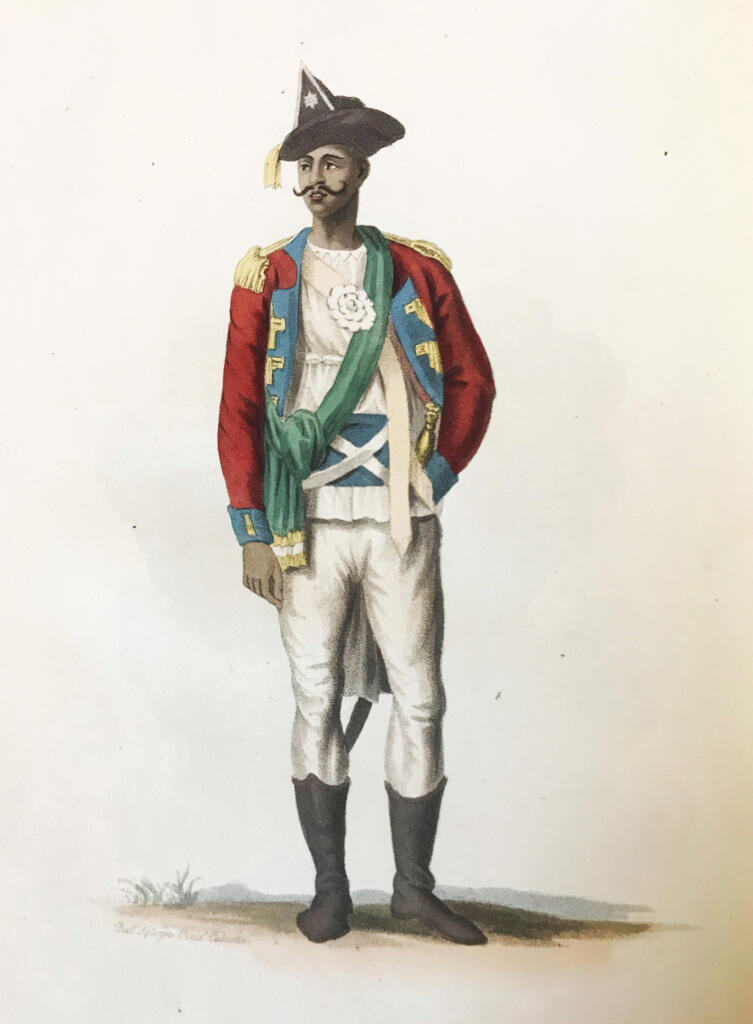
A sepoy. lithograph from The Costume of Hindostan by Baltasar Solvyns, 1807
What key changes followed the transfer of power from the East India Company to the British Crown, especially when the British took over and raised presidency armies?
“Before 1895, India had three Presidency armies: Bengal, Bombay and Madras. These armies amalgamated in 1895 to create the four command-based Indian army. The Presidency armies were recruited by the respective Presidencies and often their strength increased when European officers serving the Indian powers acceded to the British with their contingents. For instance, Skinner was a Maratha employee. He switched sides before the Second Anglo Maratha War and later Skinner’s Horse became an important regiment of the Indian army. It is now a tank regiment.”
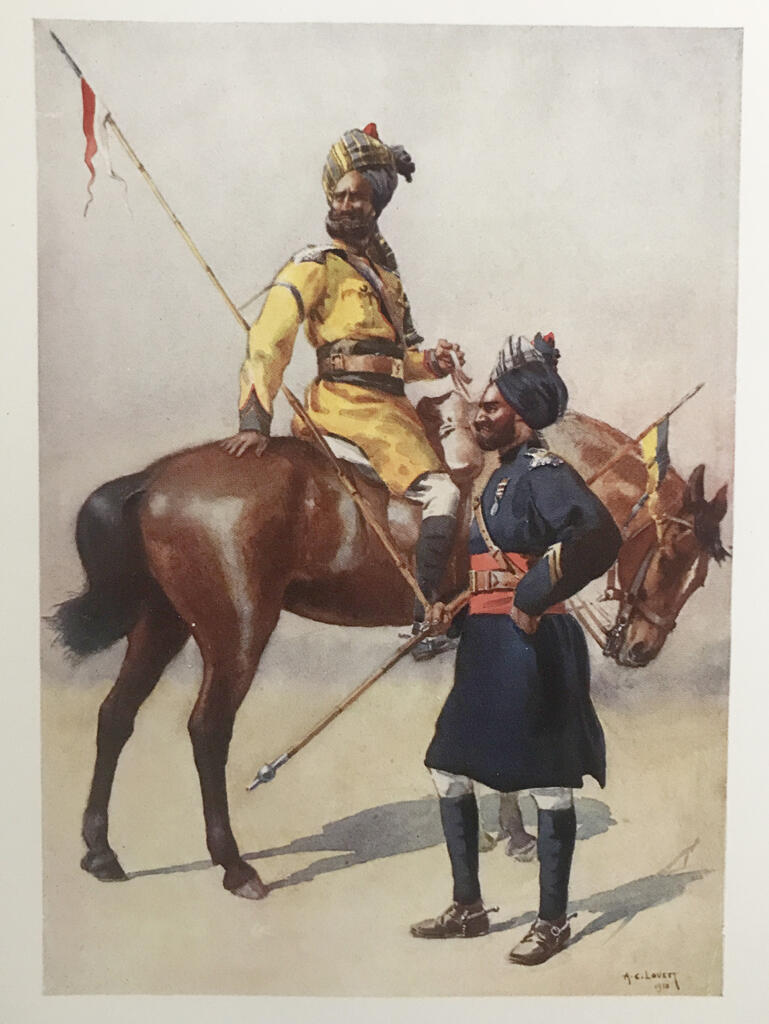
Skinner’s Horse, illustration from ‘The Armies of India’ by Major AC Lovett, 1911
Let’s end with some popular culture. What are some of your favorite war films from India?
I regularly show war films to my MA students doing courses on fascism, Nazism and colonial Indian history with me. There’s one sensitive made Indian military film I like, starring Rahul Bose and K K Menon, called Shaurya. Otherwise Indian war movies pretty much end up creating shrill nationalist noises. I usually recommend films that deconstruct the idea of war. On the Revolt of 1857, India produced a very good film: Shyam Benegal’s Junoon. It is based on Ruskin Bond’s lovely work Flight of Pigeons.
An alumnus of St. Stephen’s College and JNU, Dr. Anirudh Deshpande, is currently Associate Professor, Department of History, Faculty of Social Sciences at the University of Delhi. Dr. Deshpande has published several books on India’s modern military history and has authored more than 70 academic papers, commentaries, reviews and articles since 1987 that have appeared in prominent journals and newspapers. He is a regular commentator in the bilingual journal Forward Press dedicated to social justice. Dr. Deshpande as been a Nehru Fellow, UGC Fellow and ICHR Fellow in the past and has been invited as a guest professor at several Indian and international universities. He writes Hindi short stories, four of which have been published in newspapers and journals and also dabbles in Hindustani verse. His novel, Dreamt Lives, was published in 2018 by Solar Books, New Delhi.



